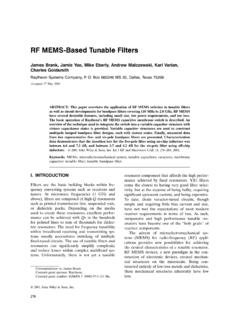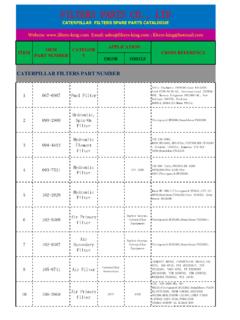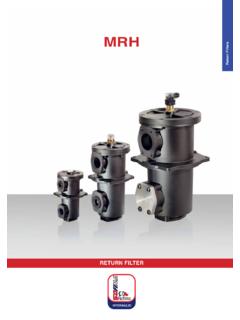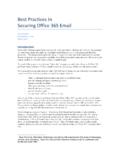Transcription of INDG174 Personal protective equipment (PPE) at work
1 Health and Safety Executive Personal protective equipment (PPE) at work A brief guide Introduction This leaflet describes what you, as an employer, may need to do to protect your employees from the risk of injury in the workplace. It will also be useful to employees and their representatives. Employers have duties concerning the provision and use of Personal protective equipment (PPE) at work and the leaflet explains what you need to do to meet the requirements of the Personal protective equipment at Work Regulations 1992 (as amended). What is PPE? This is a web-friendly PPE is equipment that will protect the user against health or safety risks at work. It version of leaflet can include items such as safety helmets and hard hats, gloves, eye protection, INDG174 (rev2), high-visibility clothing, safety footwear and safety harnesses.
2 Published 06/13. Hearing protection and respiratory protective equipment provided for most work situations are not covered by these Regulations because there are other more specific regulations that apply to them. However, these items need to be compatible with any other PPE provided. Cycle helmets or crash helmets worn by employees on the roads are not covered by the Regulations. Motorcycle helmets are legally required under road traffic legislation. The Employment Act 1989 gives an exemption for turban-wearing Sikhs working on construction sites from the need to wear head protection. What do the Regulations require? PPE should be used as a last resort. Wherever there are risks to health and safety that cannot be adequately controlled in other ways, the Personal protective equipment at Work Regulations 1992 require PPE to be supplied.
3 The Regulations also require that PPE is: properly assessed before use to make sure it is fit for purpose;. maintained and stored properly;. provided with instructions on how to use it safely;. used correctly by employees. Page 1 of 6. Health and Safety Executive Assessing suitable PPE. To make sure the right type of PPE is chosen, consider the different hazards in the workplace and identify the PPE that will provide adequate protection against them;. this may be different for each job. Ask your supplier for advice on the types of PPE available and their suitability for different tasks. In some cases, you may need to get advice from specialists or from the PPE manufacturer. Another useful source of information is the British Safety Industry Federation (www. ). Consider the following when assessing suitability: Does the PPE protect the wearer from the risks and take account of the environmental conditions where the task is taking place?
4 For example eye protection designed to protect against agricultural pesticides may not offer adequate protection when using an angle grinder to cut steel or stone. Does using PPE increase the overall level of risk or add new risks, eg by making communication more difficult? Can it be adjusted to fit the wearer correctly? What are the needs of the job and the demands it places on the wearer? For example, the length of time the PPE needs to be worn, the physical effort required to do the job or the requirements for visibility and communication. If someone wears more than one item of PPE, are they compatible? For example does using a respirator make it difficult to fit eye protection properly? Selection and use When selecting PPE: choose good quality products which are CE marked in accordance with the Personal protective equipment Regulations 2002 suppliers can advise you.
5 Choose equipment that suits the wearer consider the size, fit and weight; you may need to consider the health of the wearer, eg if equipment is very heavy, or wearers have pre-existing health issues, standard PPE may not be suitable;. let users help choose it, they will be more likely to use it. Using and distributing PPE to your employers: instruct and train people how to use it;. tell them why it is needed, when to use it and what its limitations are;. never allow exemptions for those jobs that only take a few minutes';. if something changes on the job, check the PPE is still appropriate speak with your supplier, explaining the job to them;. if in doubt, seek further advice from a specialist adviser. Personal protective equipment (PPE) at work Page 2 of 6. Health and Safety Executive The hazards and types of PPE.
6 Eyes Hazards: Chemical or metal splash, dust, projectiles, gas and vapour, radiation. Options: Safety spectacles, goggles, face-shields, visors. Note: Make sure the eye protection has the right combination of impact/dust/. splash/molten metal eye protection for the task and fits the user properly. Head Hazards: Impact from falling or flying objects, risk of head bumping, hair entanglement. Options: A range of helmets, hard hats and bump caps. Note: Some safety helmets incorporate or can be fitted with specially-designed eye or hearing protection. Don't forget neck protection, eg scarves for use during welding. Do not use head protection if it is damaged replace it. Breathing Hazards: Dust, vapour, gas, oxygen-deficient atmospheres. Options: Disposable filtering face-piece or respirator, half- or full-face respirators, air- fed helmets, breathing apparatus.
7 Note: The right type of respirator filter must be used as each is effective for only a limited range of substances. Where there is a shortage of oxygen or any danger of losing consciousness due to exposure to high levels of harmful fumes, only use breathing apparatus never use a filtering cartridge. Filters only have a limited life;. when replacing them or any other part, check with the manufacturer's guidance and ensure the correct replacement part is used. If you are using respiratory protective equipment , look at HSE's publication Respiratory protective equipment at work: A practical guide (see Further reading'). Protecting the body Hazards: Temperature extremes, adverse weather, chemical or metal splash, spray from pressure leaks or spray guns, impact or penetration, contaminated dust, excessive wear or entanglement of own clothing.
8 Options: Conventional or disposable overalls, boiler suits, specialist protective clothing, eg chain-mail aprons, high-visibility clothing. Note: The choice of materials includes flame-retardant, anti-static, chain mail, chemically impermeable, and high-visibility. Don't forget other protection, like safety harnesses or life jackets. Personal protective equipment (PPE) at work Page 3 of 6. Health and Safety Executive Hands and arms Hazards: abrasion, temperature extremes, cuts and punctures, impact, chemicals, electric shock, skin infection, disease or contamination. Options: Gloves, gauntlets, mitts, wrist-cuffs, armlets. Note: Avoid gloves when operating machines such as bench drills where the gloves could get caught. Some materials are quickly penetrated by chemicals so be careful when you are selecting them, see HSE's skin at work website ( ).
9 Barrier creams are unreliable and are no substitute for proper PPE. Wearing gloves for long periods can make the skin hot and sweaty, leading to skin problems;. using separate cotton inner gloves can help prevent this. Be aware that some people may be allergic to materials used in gloves, eg latex. Feet and legs Hazards: Wet, electrostatic build-up, slipping, cuts and punctures, falling objects, metal and chemical splash, abrasion. Options: Safety boots and shoes with protective toe caps and penetration-resistant mid-sole, gaiters, leggings, spats. Note: Footwear can have a variety of sole patterns and materials to help prevent slips in different conditions, including oil or chemical-resistant soles. It can also be anti-static, electrically conductive or thermally insulating. It is important that the appropriate footwear is selected for the risks identified.
10 Training Make sure anyone using PPE is aware of why it is needed, when to use, repair or replace it, how to report it if there is a fault and its limitations. Train and instruct people how to use PPE properly and make sure they are doing this. Include managers and supervisors in the training, they may not need to use the equipment personally, but they do need to ensure their staff are using it correctly. It is important that users wear PPE all the time they are exposed to the risk. Never allow exemptions for those jobs which take just a few minutes'. Check regularly that PPE is being used and investigate incidents where it is not. Safety signs can be useful reminders to wear PPE, make sure that staff understand these signs, what they mean and where they can get equipment , eg for visitors or contractors.














